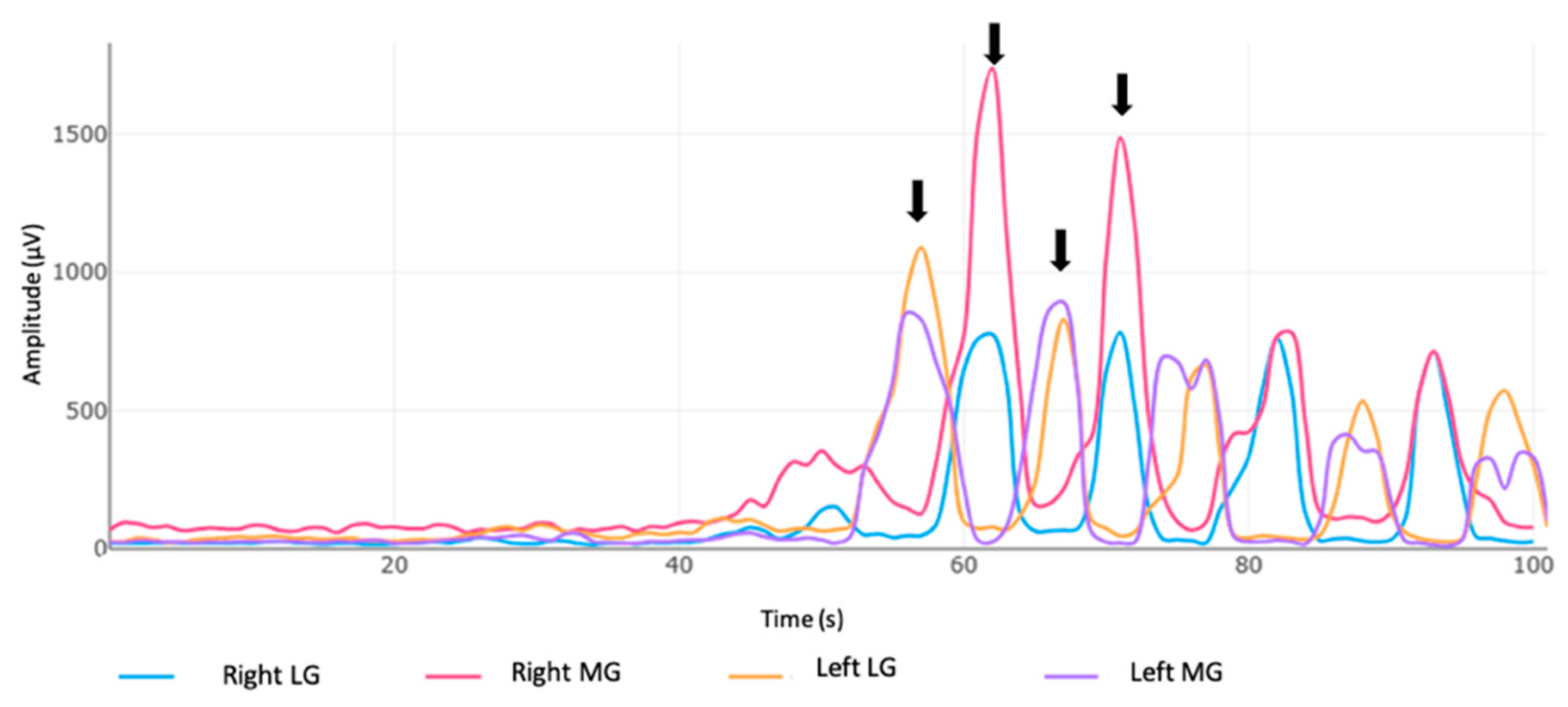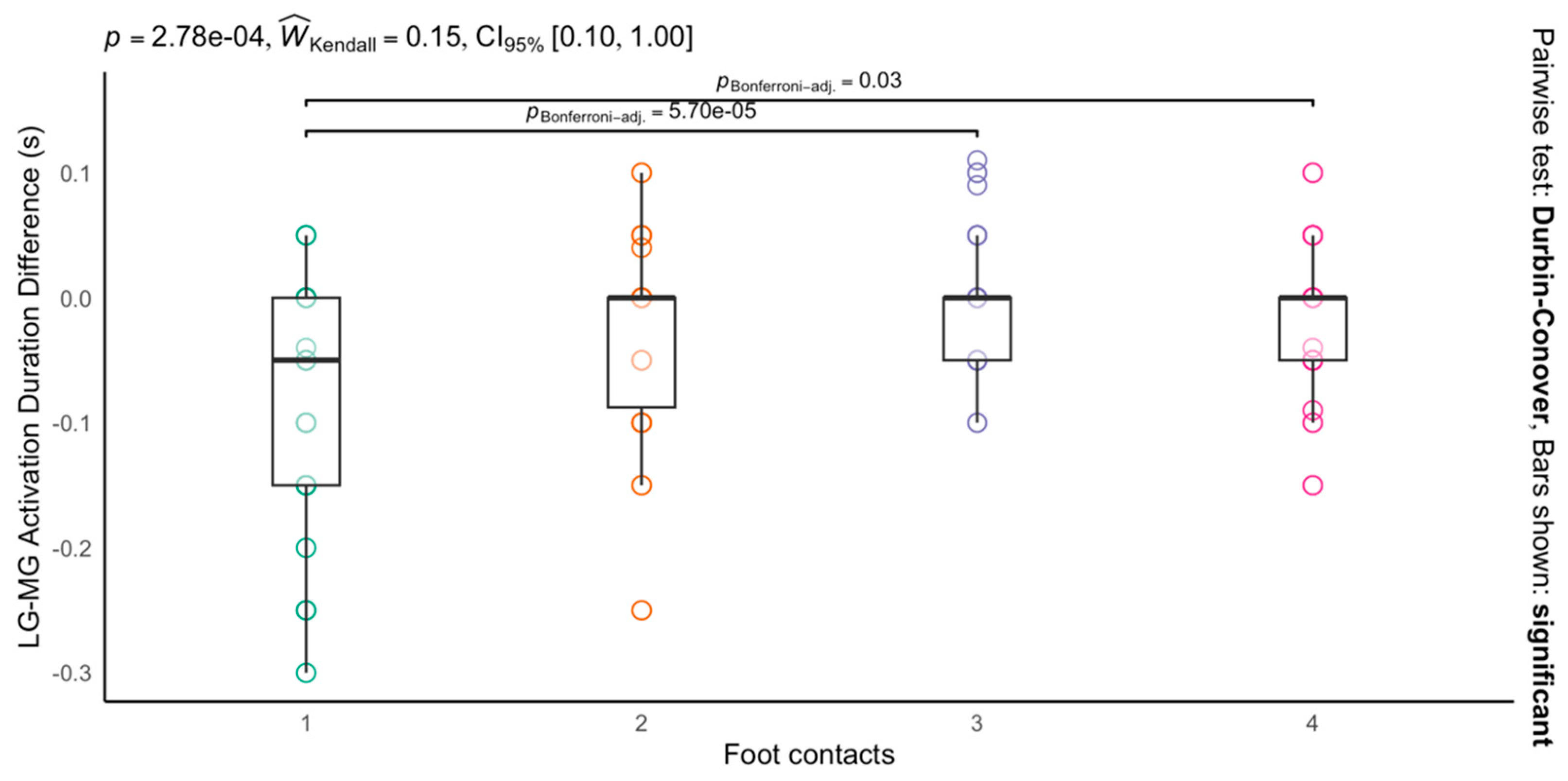Gastrocnemius Neuromuscular Activation During Standing Explosive Acceleration
Abstract
1. Introduction
2. Materials and Methods
2.1. Participants
2.2. Experimental Procedure
2.3. Procedures
2.4. Data Analysis
2.5. Statistical Analysis
3. Results
3.1. Differences in Peak sEMG and Time to Peak Activation Between Medial and Lateral Gastrocnemius
3.2. Activation Timing
3.3. Duration of Muscular Contraction at Each Foot Contact in Both Gastrocnemius
4. Discussion
4.1. Differences in Peak sEMG and Time to Peak Activation Between Medial and Lateral Gastrocnemius
4.2. Activation Timing
4.3. Experimental Recommendations and Future Research
5. Conclusions
Author Contributions
Funding
Institutional Review Board Statement
Informed Consent Statement
Data Availability Statement
Conflicts of Interest
References
- Valamatos, M.J.; Abrantes, J.M.; Carnide, F.; Valamatos, M.-J.; Monteiro, C.P. Biomechanical Performance Factors in the Track and Field Sprint Start: A Systematic Review. Int. J. Environ. Res. Public Health 2022, 19, 4074. [Google Scholar] [CrossRef] [PubMed]
- Jönhagen, S.; Ericson, M.O.; Németh, G.; Eriksson, E. Amplitude and Timing of Electromyographic Activity during Sprinting. Scand. J. Med. Sci. Sports 1996, 6, 15–21. [Google Scholar] [CrossRef] [PubMed]
- Bezodis, N.E.; Willwacher, S.; Salo, A.I.T. The Biomechanics of the Track and Field Sprint Start: A Narrative Review. Sports Med. 2019, 49, 1345–1364. [Google Scholar] [CrossRef]
- Bell, M.; Al Masruri, G.; Fernandez, J.; Williams, S.A.; Agur, A.M.; Stott, N.S.; Hajarizadeh, B.; Mirjalili, A. Typical m. Triceps Surae Morphology and Architecture Measurement from 0 to 18 Years: A Narrative Review. J. Anat. 2022, 240, 746–760. [Google Scholar] [CrossRef] [PubMed]
- Signorile, J.F.; Applegate, B.; Duque, M.; Cole, N.; Zink, A. Selective Recruitment of the Triceps Surae Muscles with Changes in Knee Angle. J. Strength Cond. Res. 2002, 16, 433–439. [Google Scholar] [PubMed]
- Dick, T.J.M.; Wakeling, J.M. Shifting Gears: Dynamic Muscle Shape Changes and Force-Velocity Behavior in the Medial Gastrocnemius. J. Appl. Physiol. 2017, 123, 1433–1442. [Google Scholar] [CrossRef]
- Tamaki, H.; Kitada, K.; Akamine, T.; Sakou, T.; Kurata, H. Electromyogram Patterns during Plantarflexions at Various Angular Velocities and Knee Angles in Human Triceps Surae Muscles. Eur. J. Appl. Physiol. Occup. Physiol. 1997, 75, 1–6. [Google Scholar] [CrossRef]
- Cibulka, M.; Wenthe, A.; Boyle, Z.; Callier, D.; Schwerdt, A.; Jarman, D.; Strube, M.J. Variation in medial and lateral gastrocnemius muscle activity with foot position. Int. J. Sports Phys. Ther. 2017, 12, 233–241. [Google Scholar]
- Marcori, A.J.; Moura, T.B.M.A.; Okazaki, V.H.A. Gastrocnemius Muscle Activation during Plantar Flexion with Different Feet Positioning in Physically Active Young Men. IES 2017, 25, 121–125. [Google Scholar] [CrossRef]
- Héroux, M.E.; Dakin, C.J.; Luu, B.L.; Inglis, J.T.; Blouin, J.-S. Absence of Lateral Gastrocnemius Activity and Differential Motor Unit Behavior in Soleus and Medial Gastrocnemius during Standing Balance. J. Appl. Physiol. 2014, 116, 140–148. [Google Scholar] [CrossRef]
- Cohen, J.W.; Gallina, A.; Ivanova, T.D.; Vieira, T.; McAndrew, D.J.; Garland, S.J. Regional Modulation of the Ankle Plantarflexor Muscles Associated with Standing External Perturbations across Different Directions. Exp. Brain Res. 2020, 238, 39–50. [Google Scholar] [CrossRef] [PubMed]
- Hamard, R.; Aeles, J.; Kelp, N.Y.; Feigean, R.; Hug, F.; Dick, T.J.M. Does Different Activation between the Medial and the Lateral Gastrocnemius during Walking Translate into Different Fascicle Behavior? J. Exp. Biol. 2021, 224, jeb242626. [Google Scholar] [CrossRef] [PubMed]
- Yong, J.R.; Dembia, C.L.; Silder, A.; Jackson, R.W.; Fredericson, M.; Delp, S.L. Foot Strike Pattern during Running Alters Muscle-Tendon Dynamics of the Gastrocnemius and the Soleus. Sci. Rep. 2020, 10, 5872. [Google Scholar] [CrossRef] [PubMed]
- Fields, K.B.; Rigby, M.D. Muscular Calf Injuries in Runners. Curr. Sports Med. Rep. 2016, 15, 320–324. [Google Scholar] [CrossRef] [PubMed]
- Koulouris, G.; Ting, A.Y.I.; Jhamb, A.; Connell, D.; Kavanagh, E.C. Magnetic Resonance Imaging Findings of Injuries to the Calf Muscle Complex. Skelet. Radiol. 2007, 36, 921–927. [Google Scholar] [CrossRef]
- Bezodis, N.E.; Trewartha, G.; Salo, A.I.T. Understanding elite sprint start performance through an analysis of joint kinematics. In Proceedings of the 26 International Conference on Biomechanics in Sports, Seoul, Republic of Korea, 14–18 July 2008. [Google Scholar]
- Howard, R.M.; Conway, R.; Harrison, A.J. Muscle Activity in Sprinting: A Review. Sports Biomech. 2018, 17, 1–17. [Google Scholar] [CrossRef]
- Schuermans, J.; Danneels, L.; Van Tiggelen, D.; Palmans, T.; Witvrouw, E. Proximal Neuromuscular Control Protects Against Hamstring Injuries in Male Soccer Players: A Prospective Study With Electromyography Time-Series Analysis During Maximal Sprinting. Am. J. Sports Med. 2017, 45, 1315–1325. [Google Scholar] [CrossRef]
- Slawinski, J.; Houel, N.; Bonnefoy-Mazure, A.; Lissajoux, K.; Bocquet, V.; Termoz, N. Mechanics of Standing and Crouching Sprint Starts. J. Sports Sci. 2017, 35, 858–865. [Google Scholar] [CrossRef]
- Slawinski, J.; Houel, N.; Moreau, C.; Mahlig, A.; Dinu, D. Contribution of Segmental Kinetic Energy to Forward Propulsion of the Centre of Mass: Analysis of Sprint Acceleration. J. Sports Sci. 2022, 40, 1282–1289. [Google Scholar] [CrossRef]
- Frost, D.M.; Cronin, J.B. Stepping Back to Improve Sprint Performance: A Kinetic Analysis of the First Step Forwards. J. Strength Cond. Res. 2011, 25, 2721–2728. [Google Scholar] [CrossRef]
- van Melick, N.; Meddeler, B.M.; Hoogeboom, T.J.; Nijhuis-van der Sanden, M.W.; van Cingel, R.E.H. How to Determine Leg Dominance: The Agreement between Self-Reported and Observed Performance in Healthy Adults. PLoS ONE 2017, 12, e0189876. [Google Scholar] [CrossRef] [PubMed]
- Molina-Molina, A.; Ruiz-Malagón, E.J.; Carrillo-Pérez, F.; Roche-Seruendo, L.E.; Damas, M.; Banos, O.; García-Pinillos, F. Validation of mDurance, A Wearable Surface Electromyography System for Muscle Activity Assessment. Front. Physiol. 2020, 11, 606287. [Google Scholar] [CrossRef] [PubMed]
- Hermens, H.; Freriks, B.; Merletti, R.; Stegeman, D.; Blok, J.; Rau, G.; Klug, C.; Hägg, G.; Blok, W.J.; Hermens, H. European Recommendations for Surface Electromyography: Results of the SENIAM Project; Roessingh Research and Development: Enschede, The Netherlands, 1999. [Google Scholar]
- Clancy, E.A.; Morin, E.L.; Merletti, R. Sampling, Noise-Reduction and Amplitude Estimation Issues in Surface Electromyography. J. Electromyogr. Kinesiol. 2002, 12, 1–16. [Google Scholar] [CrossRef] [PubMed]
- Ball, N.; Scurr, J.C. Efficacy of Current and Novel Electromyographic Normalization Methods for Lower Limb High-Speed Muscle Actions. Eur. J. Sport Sci. 2011, 11, 447–456. [Google Scholar] [CrossRef]
- Chuang, T.D.; Acker, S.M. Comparing Functional Dynamic Normalization Methods to Maximal Voluntary Isometric Contractions for Lower Limb EMG from Walking, Cycling and Running. J. Electromyogr. Kinesiol. 2019, 44, 86–93. [Google Scholar] [CrossRef]
- Luca, C.J.D. The Use of Surface Electromyography in Biomechanics. J. Appl. Biomech. 1997, 13, 135–163. [Google Scholar] [CrossRef]
- Özgünen, K.T.; Çelik, U.; Kurdak, S.S. Determination of an Optimal Threshold Value for Muscle Activity Detection in EMG Analysis. J. Sports Sci. Med. 2010, 9, 620–628. [Google Scholar]
- Cohen, J. Statistical Power Analysis for the Behavioral Sciences; Academic Press: Cambridge, MA, USA, 2013; ISBN 978-1-4832-7648-9. [Google Scholar]
- Crouzier, M.; Avrillon, S.; Hug, F.; Cattagni, T. Horizontal Foot Orientation Affects the Distribution of Neural Drive between Gastrocnemii during Plantarflexion, without Changing Neural Excitability. J. Appl. Physiol. 2024, 136, 786–798. [Google Scholar] [CrossRef]
- Crouzier, M.; Hug, F.; Dorel, S.; Deschamps, T.; Tucker, K.; Lacourpaille, L. Do Individual Differences in the Distribution of Activation between Synergist Muscles Reflect Individual Strategies? Exp. Brain Res. 2019, 237, 625–635. [Google Scholar] [CrossRef]
- Hug, F.; Del Vecchio, A.; Avrillon, S.; Farina, D.; Tucker, K. Muscles from the Same Muscle Group Do Not Necessarily Share Common Drive: Evidence from the Human Triceps Surae. J. Appl. Physiol. 2021, 130, 342–354. [Google Scholar] [CrossRef]
- Richardson, C.; Bullock, M.I. Changes in Muscle Activity during Fast, Alternating Flexion-Extension Movements of the Knee. Scand. J. Rehabil. Med. 1986, 18, 51–58. [Google Scholar] [CrossRef] [PubMed]
- Cramer, J.T.; Housh, T.J.; Weir, J.P.; Johnson, G.O.; Ebersole, K.T.; Perry, S.R.; Bull, A.J. Power Output, Mechanomyographic, and Electromyographic Responses to Maximal, Concentric, Isokinetic Muscle Actions in Men and Women. J. Strength Cond. Res. 2002, 16, 399–408. [Google Scholar] [PubMed]
- Kurtzer, I.; Herter, T.M.; Scott, S.H. Random Change in Cortical Load Representation Suggests Distinct Control of Posture and Movement. Nat. Neurosci. 2005, 8, 498–504. [Google Scholar] [CrossRef] [PubMed]
- Shadmehr, R. Distinct Neural Circuits for Control of Movement vs. Holding Still. J. Neurophysiol. 2017, 117, 1431–1460. [Google Scholar] [CrossRef] [PubMed]
- Fiebert, I.M.; Spielholz, N.I.; Applegate, E.B.; Carbone, M.; Gonzalez, G.; Gorack, W.M. Integrated EMG Study of the Medial and Lateral Heads of the Gastrocnemius during Isometric Plantar Flexion with Varying Cuff Weight Loads. J. Back Musculoskelet. Rehabil. 1998, 11, 19–26. [Google Scholar] [CrossRef]
- Sadeghi, H.; Allard, P.; Prince, F.; Labelle, H. Symmetry and Limb Dominance in Able-Bodied Gait: A Review. Gait Posture 2000, 12, 34–45. [Google Scholar] [CrossRef]
- Gao, Z.; Mei, Q.; Xiang, L.; Baker, J.S.; Fernandez, J.; Gu, Y. Effects of Limb Dominance on the Symmetrical Distribution of Plantar Loading during Walking and Running. Proc. Inst. Mech. Eng. Part P J. Sports Eng. Technol. 2022, 236, 17–23. [Google Scholar] [CrossRef]
- Velotta, J.; Weyer, J.; Ramirez, A.; Winstead, J.; Bahamonde, R. Relationship between leg dominance tests and type of task. In Proceedings of the 29 International Conference on Biomechanics in Sports, Porto, Portugal, 27 June–1 July 2011. [Google Scholar]
- Riemann, B.L.; Limbaugh, G.K.; Eitner, J.D.; LeFavi, R.G. Medial and Lateral Gastrocnemius Activation Differences during Heel-Raise Exercise with Three Different Foot Positions. J. Strength Cond. Res. 2011, 25, 634–639. [Google Scholar] [CrossRef]
- Biewener, A.A.; Roberts, T.J. Muscle and Tendon Contributions to Force, Work, and Elastic Energy Savings: A Comparative Perspective. Exerc. Sport Sci. Rev. 2000, 28, 99–107. [Google Scholar]
- Crouzier, M.; Lacourpaille, L.; Nordez, A.; Tucker, K.; Hug, F. Neuromechanical Coupling within the Human Triceps Surae and Its Consequence on Individual Force-Sharing Strategies. J. Exp. Biol. 2018, 221, jeb187260. [Google Scholar] [CrossRef]
- Komi, P.V. Stretch-Shortening Cycle: A Powerful Model to Study Normal and Fatigued Muscle. J. Biomech. 2000, 33, 1197–1206. [Google Scholar] [CrossRef] [PubMed]
- Ugbolue, U.C.; Yates, E.L.; Ferguson, K.; Wearing, S.C.; Gu, Y.; Lam, W.-K.; Baker, J.S.; Dutheil, F.; Sculthorpe, N.F.; Dias, T. Electromyographic Assessment of the Lower Leg Muscles during Concentric and Eccentric Phases of Standing Heel Raise. Healthcare 2021, 9, 465. [Google Scholar] [CrossRef] [PubMed]




| Foot Contact | Lateral Gastrocnemius | Medial Gastrocnemius | p-Value (ES) | |
|---|---|---|---|---|
| Peak sEMG (%) | First | 64.69 ± 2.44 | 65.01 ± 2.65 | 0.72 (0.1) |
| Second | 76.34 ± 3.27 | 75.50 ± 3.26 | 0.91 (0.0) | |
| Third | 76.48 ± 3.10 | 66.91 ± 2.25 | 0.01 (0.5) | |
| Fourth | 68.86 ± 2.54 | 66.79 ± 2.56 | 0.62 (0.1) | |
| Time to peak sEMG (s) | First | 0.16 ± 0.01 | 0.20 ± 0.02 | 0.06 (0.4) |
| Second | 0.13 ± 0.01 | 0.16 ± 0.02 | 0.10 (0.4) | |
| Third | 0.12 ± 0.01 | 0.13 ± 0.01 | 0.02 (0.5) | |
| Fourth | 0.11 ± 0.01 | 0.13 ± 0.01 | 0.14 (0.4) |
Disclaimer/Publisher’s Note: The statements, opinions and data contained in all publications are solely those of the individual author(s) and contributor(s) and not of MDPI and/or the editor(s). MDPI and/or the editor(s) disclaim responsibility for any injury to people or property resulting from any ideas, methods, instructions or products referred to in the content. |
© 2024 by the authors. Licensee MDPI, Basel, Switzerland. This article is an open access article distributed under the terms and conditions of the Creative Commons Attribution (CC BY) license (https://creativecommons.org/licenses/by/4.0/).
Share and Cite
Ferri-Caruana, A.; Sendra-Pérez, C.; Priego-Quesada, J.I. Gastrocnemius Neuromuscular Activation During Standing Explosive Acceleration. Life 2024, 14, 1378. https://doi.org/10.3390/life14111378
Ferri-Caruana A, Sendra-Pérez C, Priego-Quesada JI. Gastrocnemius Neuromuscular Activation During Standing Explosive Acceleration. Life. 2024; 14(11):1378. https://doi.org/10.3390/life14111378
Chicago/Turabian StyleFerri-Caruana, Ana, Carlos Sendra-Pérez, and Jose Ignacio Priego-Quesada. 2024. "Gastrocnemius Neuromuscular Activation During Standing Explosive Acceleration" Life 14, no. 11: 1378. https://doi.org/10.3390/life14111378
APA StyleFerri-Caruana, A., Sendra-Pérez, C., & Priego-Quesada, J. I. (2024). Gastrocnemius Neuromuscular Activation During Standing Explosive Acceleration. Life, 14(11), 1378. https://doi.org/10.3390/life14111378







